Magic Origins Prerelease Primer
Every hero has their beginning.
For a Planeswalker, there's a moment when your spark ignites. When, upon encountering a particularly traumatic event, you learn to walk between worlds and unlock power beyond all things you previously thought possible.
Whether you're unlocking your spark for the very first time, or are a wizened Planeswalker who has been all around the Multiverse, Magic Origins has plenty for you.
And it all starts at the Prerelease!
The Prerelease is your first chance to come out and play with the new cards. You can come out, get your hands on Magic Origins cards before anybody else, and explore the reaches of the Multiverse. Magic Origins is a set truly unlike any other—are you ready?
Prerelease Beginnings
In all of Magic, Prereleases have always been among some of my favorite tournaments.
When I was eleven I went to my very first Prerelease—and it was so much fun I've been coming back ever since. They're great because the set is brand new, the footing is fairly equal as everybody plays with the set for the very first time, and you're all just relaxing and having fun exploring the new cards. It's just a lot of fun!
If you're a Sealed Deck veteran, you may want to skip ahead to the next section, where I talk about some of the differences you can expect at your local store for Magic Origins. But if you're new to this whole crazy Sealed Deck shindig, or are maybe just looking for a few extra pointers, then read on!
Alright. So let's go over perhaps the most important part: finding a place to play a Prerelease! After all, you can't very well play if you don't know where to go. How might you go about that?
Well, if you don't already have a local shop you frequent, be sure to check out the store locator to find one near you! That store may even offer preregistration. Prereleases are one of the most popular events we put on, so be sure to check and see if the store preregisters. The best time to find out an event is full is decidedly not when you show up and learn you can't play, so be sure to look ahead.
Alright, so you've found your store—excellent!
Now it's time to prepare. Magic Origins hops across ten different planes in the Magic Multiverse, and so there will be plenty to do on this Multiverse field trip—and you'll want to be prepared. While you'll be building your deck for the event with cards you're given when you get there, there's plenty to do beside just that.
For example, you may still want to bring a Standard or Commander deck to play between rounds for fun, a trade binder, pen and paper to keep track of life, and even a water bottle plus something small to snack on. (Word on the Multiverse street is that granola bars make for great snacks.) You can expect a Prerelease event to take about four to five hours, so you'll want to make sure you set aside enough time for the entire event.
Okay now, let's see. You have a store and you've gathered everything you might need as you visit the ten planes of Magic Origins. You've even read through all of the Magic Origins Planeswalkers' stories so you can school all of your opponent's at Magic lore and glanced at the Card Image Gallery.
You're all set! Now it's time for…
A Guide to Deck building
If you've been playing a lot recently, Magic Origins is something that harkens back to the core of Sealed Deck building: two color decks. And to help choose one of your two colors, you'll be choosing which Planeswalker to align yourself with! This doesn't necessarily mean you'll received their Planeswalker card in your box, but it certainly helps your odds!
There are five Planeswalkers sharing focus in Magic Origins. To recap, they are:
Gideon
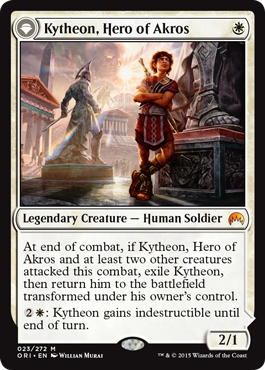
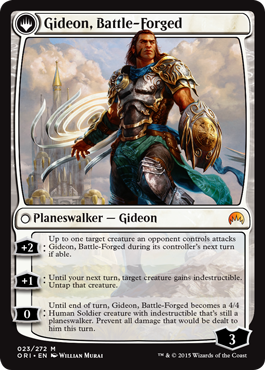
Gideon Jura—also known as Kytheon Iora—is a white Planeswalker from the world of Theros that can command an army…and is equally happy to get his hands dirty and fight when he needs to! Especially impervious, Gideon is indestructible while fighting, so taking him down can be tricky.
If you choose Gideon, you'll receive some Gideon-focused white cards—which means you'll be a bit more inclined to amass an army and attack.
Jace
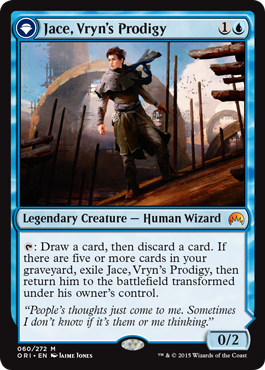
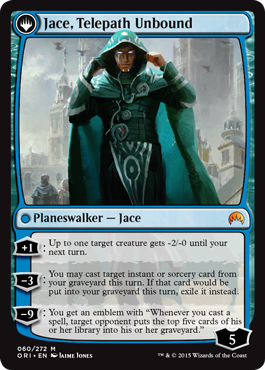
The tricky mind-mage, Jace Beleren, who hails from Vryn, will outwit you in every way—and then make you forget it ever happened. He has even been known to erase his own memory from time to time.
…What was I talking about again?
Oh, right. This blue Planeswalker is full of traditional blue tricks. And whether it's drawing cards, returning creatures to their owner's hand, or countering spells, you can expect Jace to do it.
Liliana
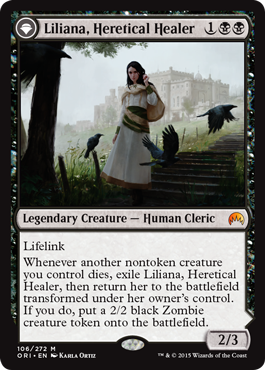
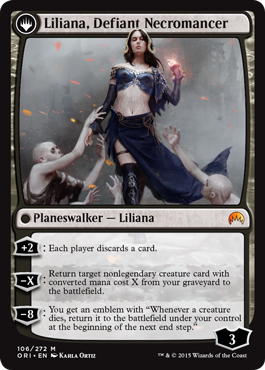
Death is no barrier for Liliana Vess. This necromancer originally from Dominaria seeks dominance over death…and she has plenty of time to do it, seeing that a pact with demons has granted her eternal life!
Align yourself with Liliana and you can expect to have some cards that make your opponent discard cards, destroy creatures, and (of course) some lovely zombies.
Chandra
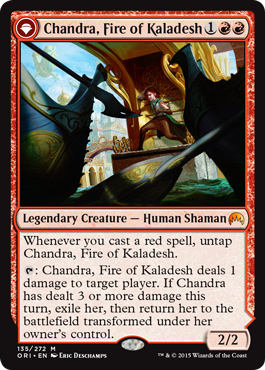
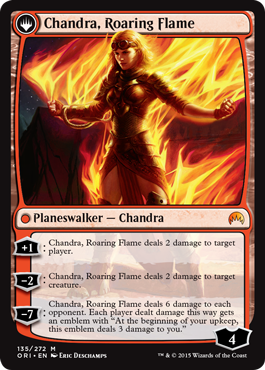
Impulsive and quick-tempered, Chandra Nalaar commands fire. Born on the plane of Kaladesh, she has since learned how to better take advantage of her powerful fiery magic.
If you choose Chandra, one thing is certain: burn! Whether you want to kill creatures or just melt off your opponent's face, Chandra will help you do that.
Nissa
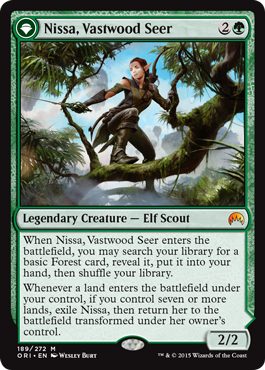

The Elf Planeswalker Nissa Revane comes from Zendikar and wields powerful elemental Magic. She is attuned with the land in a way few others are, feeling the entire world of any plane she's on.
Pick Nissa, and you will likely have a mix of ways to ramp up your lands and big creatures to play with them. Nissa will help make sure your lands cooperate.
Okay! So, do you have an idea of which Planeswalker you may want to choose? Feel free to take your time and think it over.
Once you do know which you want, you'll go to your store, choose your Planeswalker (or, if you preregistered, perhaps you already chose when you did that), receive a Planeswalker-themed box, and it's off to the races!
Inside this box you'll find a lot of neat things. But key to your day are going to be the seven booster packs that will give you the cards you need to build your Sealed Deck: six normal Magic Origins boosters, and one seven-card booster full of cards of the color of the Planeswalker you chose.
First things first: unlock the secrets of the Multiverse. By which, I mean: rip those packs open! Then, you'll have a stack of cards.
So…what now?
It's time to build your deck, of course!
Sealed Deck is a little different from normal deck building. You get to build a deck only out of the cards in front of you, plus as many basic lands as you'd like. Also, unlike a normal Constructed deck, where the minimum deck size is 60, you only have to play 40 cards.
Deck building in Sealed can be tricky—and this is where that special booster comes in!
When you picked your box, you chose a Planeswalker. And that Planeswalker matches up with the contents of your special "seed booster" that was wrapped in plastic as you opened your box. This "seeded deck" experience helps you figure out what color to play. Since Magic Origins seed boosters contain seven cards, all of the color of the box you chose, you should be all set to play that color with this huge boost.
While you are allowed to play any colors you want, most often it's going to be advantageous to play the color you chose. (Plus, I would hope that you chose a Planeswalker that matched with a color you wanted to play!) So, what I would recommend is to take the color of your box and then figure out which color compliments it well. It could be that there's a cool card you really want to play, or just that you chose green and don't have many cheap to cast creatures so red helps plug that hole nicely.
Whatever your method, you're going to need to narrow down what you're playing.
So how do you take everything you have and figure out which 22–23 cards you're going to want to put in your deck? Let's go and poke it with a stick.
… Or, preferably, lay the cards in your colors and lay the creatures out in mana-cost order. This helps you see what creatures you're going to potentially have to cast at each part of the game. (Don't lay your noncreatures out at this point unless they're cards you are planning to play as soon as you have that much mana—for example, you will generally cast a Goblin Glory Chaser on turn one, but a Fiery Impulse usually not.)
A good "mana curve" of creatures is crucial to a successful Sealed Deck. You don't want to have a ton of cards at any single spot in the curve: it's important for you to be able to have a good mix so you can play your cheap spells in the early game and your expensive spells in the late game. As a very general rule for Limited, I would look to play something like this:
1 mana: 0–2 creatures
2 mana: 4–6 creatures
3 mana: 3–5 creatures
4 mana: 4 creatures
5 mana: 3 creatures
6+ mana: 1–2 creatures
That's far from hard and fast, but it's a good place to start. Cull your creatures down to these numbers by choosing your favorites.
Now that you have your core creature base figured out, it's time to add in spells! Pick your favorites among your colors to bring your deck to 22 or 23 cards, and then you're good to go from the spell side!
The spells you're going to want the most are what are called "removal spells"—these are the spells that permanently neutralize your opponent's creatures, either by damage, keeping them tapped, or just straight-up destroying them. Sealed Deck Magic is all about creatures, so you'll want to play most of the cards in your colors that can get rid of opponent's creatures.
Interested in more tips? Here are a few more things to keep in mind for deck building:
- You can play more than 40 cards, but you really should stick to 40 if you can. Every card over 40 you play just means it's that much less likely you're going to draw that awesome rare you put in your deck!
- The land ratio you're looking at should be about 17 lands to 23 nonlands. This isn't right 100% of the time, but most Limited decks end up looking like this and, in general, it's what I would want to have.
- Play a mix of cheap- and expensive-to-cast cards. If you have all cheap, small creatures, then a single big creature can shut you down. But if you have all expensive, large creatures you risk getting run over first. Stick to a mix that focuses on the two-, three-, four-, and five-casting cost creatures. More games of Sealed Deck are won by casting a creature every turn starting on turn two or three than any other way.
- Evasion is important! Often, Sealed Deck games will get into stalls where both players have a lot of creatures and neither player can attack very well. Creatures with abilities like flying ensure that you can break through these creature stalls.
If you want to dive really deep into Sealed, here are a few articles you can check out to learn even more:
- "Sealed Deck"
- "How I Break Down My Sealed Pool"
- "Prerelease Prerogatives"
- "Sealed Deck Reality Check"
- "Foundations"
- Nate Price's Price of Progress series
- The original "Prerelease Primer"
Two-Headed Giant
Some stores also support a version of Sealed Deck called Two-Headed Giant (often abbreviated "2HG"), where two players team up against other pairs of players. Each pair gets two Prerelease Packs (they don't have to be the same Planeswalkers, even; you can figure out your own awesome Planeswalker team-up!) from which the players build their decks. Your tournament organizer can tell you more about 2HG if your store supports it.
Open Dueling
If the idea of spending a day playing a tournament scares you, or if you have less time and just want to experience some low-key games with Magic Origins, you can get involved in Open Dueling.
In these events, you get a ready-to-play 60-card Intro Pack and use it to do battle against others participating in Open Dueling, including players participating in the main tournament who are between rounds! This is a great way to dip your toe into the water if you aren't sure the Prerelease is something you want to do, or if you can't commit five hours to a Prerelease event, you can just play games in Open Dueling at your own leisure. Plus, it's fun!
But Wait, There's More!
In addition to all of those neat regular cards you found inside your box, you received a couple other cool things as well!
The first is your Prerelease promo card. You can play with this in your deck—and there's a good chance you'll want to—so be sure to put it in your deck-building stack! It's one of eight different rares (well, seven rares and one mythic rare) in your color. If you open just right, you can even pull out a double-faced Planeswalker as your Prerelease promo!
You'll also end up with one of these nice Spindown life counters:
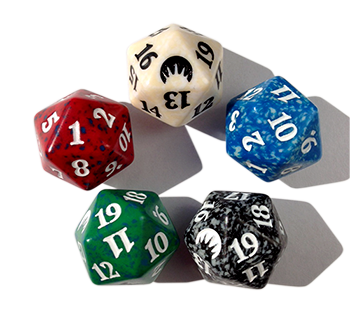
And last, but certainly not least, is one of my favorite pieces of the Origins Prerelease packs—the story booklets:




Nissa’s story is out this Wednesday, so we’re holding back the story booklet for now.
You'll find one of these in each Prerelease Pack, for the appropriate Planeswalker you chose. On them is some backstory on the Planeswalker you chose, some gorgeous artwork, and some achievements you can try and accomplish over the course of the Prerelease that walk you through that Planeswalker's story!
Can you trace the same steps that your Planeswalker walked during their Origin Story? Challenge yourself to complete these achievements during the Prerelease!
Past Origins, New Abilities
There's plenty new happening in Magic Origins! Let's go over all of the mechanics in the set one-by-one, courtesy of the Mechanics of Magic Origins article:
Double-Faced Planeswalkers
Each face has its own set of characteristics—name, type, subtype, abilities, mana cost (or no mana cost for the back face), and so on. When a double-faced card isn't on the battlefield, you consider only the characteristics of the front face.
A double-faced card enters the battlefield with its front face up by default. This is true whether it enters the battlefield after being cast or in any other way, such as being put onto the battlefield with a card like [autocard]Rise from the Grave[/autocard]. You can't cast the Planeswalker face of these cards.
Putting Double-Faced Cards in Your Deck
You have two options when putting a double-faced card in your deck: You can play with opaque card sleeves (you may already do this); or you can use a checklist card, which can be found in some Magic Origins booster packs.
Only official checklist cards may be used to stand-in for double-faced cards in a deck. If you use a checklist card to represent any of the double-faced cards in your deck, you must use checklist cards to represent all of them.
Renown
Renown triggers the first time a creature with renown deals combat damage to player. The ability puts some number of +1/+1 counters on that creature (the number after the renown keyword). Also, it causes the creature to become renowned.
Renown won't trigger if the creature deals combat damage to a Planeswalker. In the unlikely event that the creature deals combat damage to its controller (through a damage redirection effect), renown will trigger. A creature that's renowned stays renowned until it leaves the battlefield, even if it somehow loses all its +1/+1 counters.
Spell Mastery
You count the number of instant and/or sorcery cards in your graveyard as a spell is resolving to determine if the spell mastery ability applies. Don't count the resolving spell itself. It's still on the stack at that point, not in your graveyard.
Menace
A creature with menace can't be blocked except by two or more creatures. Once a creature with menace is legally blocked by two or more creatures, removing those blockers from combat won't change or undo the block.
Prowess
Prowess is a triggered ability that gives a creature +1/+1 until end of turn whenever you cast a noncreature spell. Creature spells won't cause prowess to trigger, even if those spells have other card types, such as an artifact creature spell.
Scry
To scry N (where N is a number), look at that many cards from the top of your library. Then, put any number of them on the bottom of your library in any order and the rest on top of your library in any order.
Your Origins Story
New or old, Magic Origins is full of goodies for all kinds of players alike.
I've been playing this game for years, and sets like Magic Origins still continue to surprise and delight me with the innovations inside. This Prerelease is going to be a blast!
For one last fun piece to look over, here's a chart of each of the five Planeswalkers and the two planes you'll see their cards span at the Prerelease: both their home plane and the first plane they planeswalk to. Take a look:
| Planeswalker | Home Plane | First-Planeswalk Plane | |
|---|---|---|---|
|
Gideon |
Theros |
Bant |
|
|
Jace |
Vryn |
Ravnica |
|
|
Liliana |
Dominaria |
Innistrad |
|
|
Chandra |
Kaladesh |
Regatha |
|
|
Nissa |
Zendikar |
Lorwyn |
Oh, and if you'd like to go check out the many awesome cards you could open in the set, don't miss the full Card Image Gallery—it has all of the cards in the set ready for your viewing pleasure!
If you have any questions at all about the Prerelease or what you should expect, feel free to send a tweet my way or ask me a question on my Tumblr and I'll be sure to take a look and help you out as much as I can!
Have fun this weekend. May you have a wonderful Origins story to share!
Gavin

